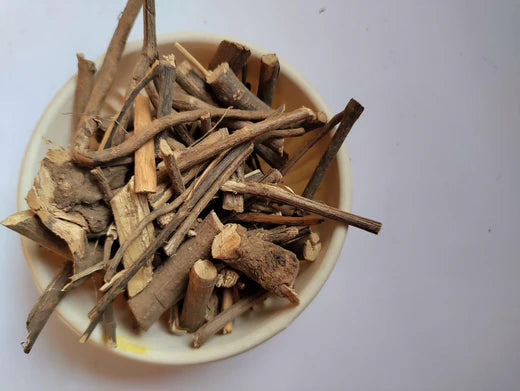Uraria picta, often known as prishniparni, is an erect perennial herb that grows to a height of 0.9–1.8 meters. The 20–30 cm long, imparipinnate leaves have 5–9 leaflets. The top stem has 5-7 (rarely 9) linear-oblong leaflets that are 10–20 cm long, sharp, blotched with white, minutely hairy beneath, and have a rounded base. The leaflets are narrowly lanceolate, ranging in length from 7 to 25 cm (smaller at the base), frequently variegated, glossy, and hairless on top, rough and hairy underneath; the margins are entire. The inflorescence is a long, terminal spike-like raceme with many flowers, up to 55 cm in length, covered in long, whitish hairs; the flowers are pink, bluish, or reddish, and the fruit is 5 to 9 mm long, folded into 3-6 segments, brown to black in color, turning greyish-white as it ages.
General Information
Prishniparni is regarded as one of the most significant herbs in Ayurveda. It is one of the ten herbs that make up the Dashamoola group. This herb provides innumerable health benefits for people. Abromodisiac, antiseptic, anti-inflammatory, antibacterial, anti-emetic, analgesic, cardiovascular, expectorant, and analgesic qualities abound in this herb. When used as a remedy for broken bones, this herb works wonders. Every portion of the plant has a wealth of medicinal qualities. This herb contains a variety of phytochemical substances, including phenols, alkaloids, flavonoids, steroids, terpenoids, and saponins. These phytochemical substances are all rich in biological activists that shield the body from a variety of chronic illnesses. Research has shown that this herb's alkaloid extracts have antiarrhythmic, anticholinergic, analgesic, anticancer, anti-HIV, and anti-leukemic properties.
Classification
- Kingdom: Plantae
- Phylum: Tracheophyta
- Class: Magnoliopsida
- Order: Fabales
- Family: Fabaceae
- Genus: Uraria
- Species: picta
Habitat
It is found in large quantities in the Philippines, Australia, Africa, India, Bangladesh, Sri Lanka, Malay Islands, Tropical Africa, and nearly every region of Asia. It grows in the sub-Himalayan region from Kashmir to West Bengal and Assam, in dry grasslands and open forests.
Names
- Latin name - Uraria picta
- Hindi name - Dabra, Pithavan
- Sanskrit names - kalashi, Dhavani, Guha, Shrugalavinna, Chitraparni, Anghriparni, Prishniparni, Prithakparni,
- Common name - Dabra
- Tamil name - Sittirappaladai, Kolaponna
Ayurvedic Properties
|
|
Hindi / Sanskrit |
English |
|
Rasa (Taste) |
Madhur, Tikta |
Sweet, Bitter |
|
Guna (Physical Property) |
Laghu |
Light |
|
Virya (Potency) |
Ushna |
Hot |
|
Vipaka (Post-Digestive Taste) |
Madhura |
Sweet |
Effects on Doshas
It balance the vata and kapha doshas
Classical Categorization
|
Charak Samhita |
Sushrut Samhita |
Vagbhata |
|
|
|
Practical Uses
- The therapeutic qualities of this plant are very helpful in the process of repairing broken bones. In the afflicted areas, it also lessens discomfort.
- Gonorrhea can be effectively treated with the use of this herb. This herb helps relieve the symptoms of gonorrhea, including pain in the penis, vagina, painful urination, abdominal pain, pelvic pain, pus-like discharge, and bleeding.
- This herb has aphrodisiac qualities in its roots. It supports libido and sexual desire growth. The use of this plant is therefore highly beneficial for preserving the body's vitality, stamina, and sexual health.
- It is well known that using this herb to treat diarrhea works well. It aids in the management of symptoms such as bloating, fever, cramping in the abdomen, loose, watery stools, and blood in the stool.
- The herb's expectorant qualities are highly beneficial in treating respiratory conditions such as bronchitis, asthma, common colds, and cough. It facilitates the removal of mucus from the nasal and pulmonary passages.
- Because of its antiseptic qualities, this herb is useful in treating a variety of bacterial, fungal, and viral illnesses.
- This herb works well for treating malaria.
- This herb's cardiovascular qualities promote heart health. Through blood vessel dilatation, these aid in maintaining the body's healthy blood flow. This decreases LDL levels and helps the body maintain healthy HDL levels. It is also highly effective in doing so. Additionally, this herb maintains the body's normal blood pressure levels.
- Additionally, this herb has antiarrhythmic properties. It aids in the management of issues related to irregular cardiac rhythms, such as ventricular tachycardia, atrial fibrillation, and atrial flutter.
- Additionally, this herb has a wealth of anti-cancer effects. It promotes the proliferation of healthy cells while slowing the growth of cancerous ones.
- This herb has anticholinergic characteristics. Therefore, using this herb to treat issues like sadness, anxiety, and sleep issues is quite effective. The analgesic qualities of this herb aid in easing physical discomfort.
Parts Used
- Roots
Dosage
- Half - one gram

